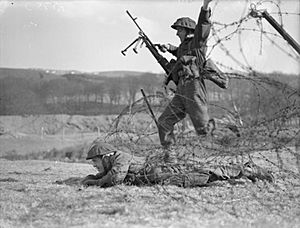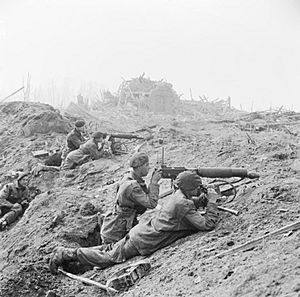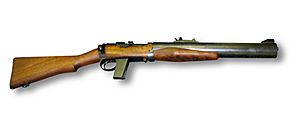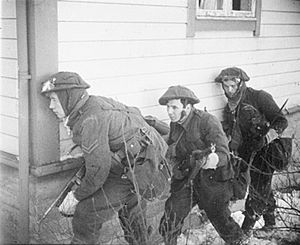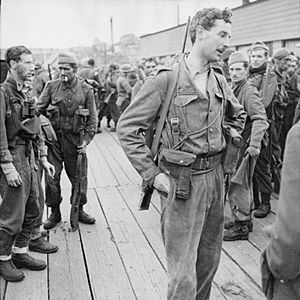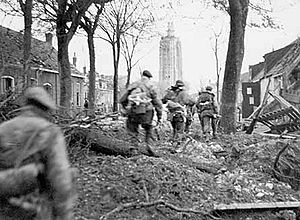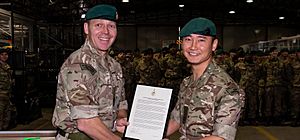Commandos (United Kingdom) facts for kids
Quick facts for kids Commandos |
|
|---|---|
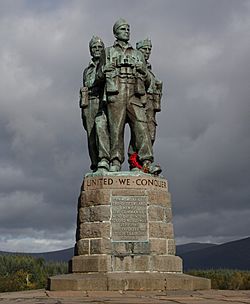
|
|
| Active | 1940–1946 |
| Allegiance | |
| Branch | |
| Type | Commando |
| Role | Coastal raiding Special operations Light infantry |
| Part of | Combined Operations |
| Engagements | Second World War |
| Commanders | |
| Notable commanders |
Robert Laycock John Durnford-Slater Lord Lovat Ronnie Tod |
| Insignia | |
| Combined Operations Tactical recognition flash |
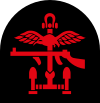 |
The Commandos, also known as the British Commandos, were a special group of soldiers formed during World War II in June 1940. They were created after Winston Churchill, the British Prime Minister, asked for special forces. These forces would carry out surprise attacks, called raids, against areas in Europe controlled by Germany.
At first, Commandos were British Army soldiers who volunteered. Later, people from all parts of the British Armed Forces joined. Many foreign volunteers from German-occupied countries also became Commandos. By the end of the war, 25,000 men had completed the tough Commando training. This included volunteers from countries like Greece, France, Belgium, and the Netherlands. Even American soldiers, like the United States Army Rangers, were inspired by the Commandos.
During the war, there were over 30 Commando units and four large groups called brigades. They fought in every part of the war, from the cold Arctic Circle to the hot Mediterranean. Their missions ranged from small teams landing from the sea to large groups leading major invasions.
After the war, most Commando units were disbanded. Only the 3 Commando Brigade of the Royal Marines continued. Today, the Royal Marine Commandos, Parachute Regiment, and Special Air Service all trace their beginnings back to these original Commandos. Other countries, like France and the Netherlands, also have special forces influenced by the wartime Commandos.
Contents
How the Commandos Started
The British Commandos were a special part of the British Armed Forces created in June 1940. After the British Army had to leave Dunkirk during the Battle of France, Britain needed a way to fight back. Prime Minister Winston Churchill wanted a force that could attack the Germans and boost British spirits.
On June 6, 1940, Churchill asked his military leaders to plan attacks on German-controlled Europe. He wanted "specially-trained troops of the hunter class" to cause trouble along the coasts. General John Dill and his assistant, Lieutenant-Colonel Dudley Clarke, came up with the idea. They suggested a new force based on the tactics of Boer commandos: "hit sharp and quick – then run to fight another day." This is how they became known as 'The Commandos'. The very first Commando raid, Operation Collar, happened on June 24/25, 1940.
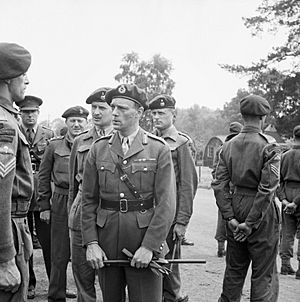
At first, only soldiers already in the Army could volunteer. These included men from special "Independent Companies" who had fought in Norway. By late 1940, over 2,000 men had volunteered. In November 1940, these new units formed the Special Service Brigade. It had four battalions under Brigadier Joseph Charles Haydon.
The Special Service Brigade quickly grew to 12 units, each called a Commando. Each Commando had about 450 men, led by a lieutenant-colonel. These men were divided into 75-man "troops," which were then split into 15-man "sections." Commandos kept their original regimental badges and pay. The Commando force was controlled by the Combined Operations Headquarters. Admiral Roger Keyes was the first commander, followed by Vice Admiral Lord Louis Mountbatten in 1941.
How Commandos Were Organized
Commando Units
Many Commando units were formed in the United Kingdom, like No. 1, No. 2, and No. 3 Commando. Four more units were formed in the Middle East. No. 10 (Inter-Allied) Commando was special. It was made up of volunteers from countries occupied by Germany, like France, Belgium, and Norway. It also included a troop of "enemy aliens," who were often refugees from Nazi Germany.
Some Commandos had specific jobs. No. 2 Commando was meant to be a parachute unit. It later became the 1st Parachute Battalion. Other Commandos, like Layforce, were sent to the Middle East. The famous Special Air Service and Special Boat Squadron were formed from the survivors of Layforce. No. 14 (Arctic) Commando trained for operations in the cold Arctic Circle. They used small boats to attack ships. No. 30 Commando focused on gathering intelligence. They learned how to find enemy documents, open safes, and handle prisoners.
No. 62 Commando, also called the Small Scale Raiding Force, was a small 55-man unit. It worked with the Special Operations Executive (SOE) to carry out secret raids. One famous raid was Operation Postmaster on the Spanish island of Fernando Po.
In February 1941, Commandos were reorganized. Each unit now had a Headquarters and six troops. Each troop had three officers and 62 other ranks. This size meant two full Commando units could fit into certain landing ships. They had some vehicles for training, but not for missions.
In 1942, the Royal Marines also started their own Commando units. They formed nine units, from No. 40 to No. 48 Commando. Later, the Royal Naval Commandos were created to help with beach landings. The Royal Air Force Commandos were formed to help make airfields ready and defend them during invasions.
1943 Changes
In 1943, the way Commando units were set up changed again. Each Commando now had a small headquarters, five fighting troops, a heavy weapons troop, and a signals team. Fighting troops had 65 men, divided into sections and subsections. The heavy weapons troop used 3-inch mortars and Vickers machine guns. Commandos also got vehicles to take with them on missions, like Jeeps and trucks.
By this time, Commandos started doing fewer small raids. Instead, they were grouped into four large brigades. These brigades would lead future Allied landing operations. The Special Service Brigade Headquarters was replaced by the Headquarters Special Services Group. Most of the 20 Commando units joined these new brigades.
Three Commandos (Nos. 12, 14, and 62) continued small-scale raids. But due to many missions and not enough volunteers, they were disbanded by the end of 1943. The small raiding role then went to the French troops of No. 10 (Inter-Allied) Commando.
In 1944, the Operational Holding Commando Headquarters was formed. It had two sub-units that trained Commandos to replace those lost in battle. In December 1944, the four Special Service brigades were renamed Commando brigades.
Commando Training
When Commandos first formed in 1940, each unit was in charge of its own training. It was hard because there wasn't much equipment after the British Army left most of it at Dunkirk. In December 1940, a Commando training base was set up in the Middle East.
In February 1942, the main Commando training depot was opened at Achnacarry in the Scottish Highlands. It was led by Lieutenant-Colonel Charles Vaughan. This depot trained whole units and individual replacements. The training was very new and physically demanding, much tougher than regular army training. The instructors were chosen because they could do everything better than the volunteers.
Training started the moment volunteers arrived. They had to march 8-mile (13 km) with all their gear from the train station to the depot. Vaughan told them that anyone who couldn't keep up would be sent back to their old unit.
They used real bullets and explosives during exercises to make training as realistic as possible. Being physically fit was key. They did cross-country runs and boxing matches. They marched quickly and for long distances up mountains and over assault courses. One course included a zip-line over Loch Arkaig. All this was done while carrying weapons and full equipment. Training went on day and night. It included crossing rivers, climbing mountains, unarmed combat, map reading, and small boat operations.
Living conditions at the camp were basic. Trainees slept in tents or Nissen huts and cooked their own food. Military rules were strict: officers were saluted, and uniforms had to be clean. The final exercise for each course was a pretend night beach landing, again using live ammunition.
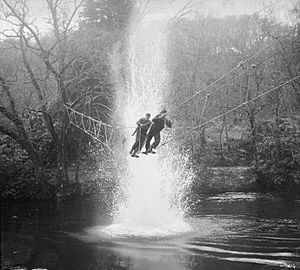
Another smaller Commando depot was at Braemar. This camp taught mountain and snow warfare. It was run by famous mountaineers, Squadron Leader Frank Smythe and Major John Hunt. They trained Commandos for Arctic conditions, including climbing snowy mountains and using small boats. They also learned how to live, fight, and move on foot or skis in the snow.
In 1943, training changed. It focused more on being assault infantry and less on small raids. Commandos learned how to call for artillery and naval gunfire support. They also learned how to get air support from Allied planes. More emphasis was placed on units working together in brigades.
By the end of the war, 25,000 men had gone through the Commando course at Achnacarry. This included British volunteers and those from Belgium, France, the Netherlands, Norway, and Poland. The United States Army Rangers also trained there.
Weapons and Gear
Commandos were a raiding force, so they didn't carry the heavy weapons of a normal infantry battalion. They used standard British Army small arms. Most riflemen carried the Lee–Enfield rifle. Sections used the Bren light machine gun for fire support. The Thompson submachine gun was popular, but later the cheaper Sten gun was also used. Commando sections had more Bren and Thompson guns than regular infantry.
The Webley Revolver was the standard sidearm at first. It was later replaced by the Colt 45 pistol, which used the same ammunition as the Thompson. Another pistol was the Browning Hi Power. One weapon made just for Commandos was the De Lisle carbine. It was based on the Lee–Enfield rifle and had a silencer. It used the same .45 cartridge as the Thompson. This weapon was designed to quietly eliminate guards during raids.
The Fairbairn–Sykes fighting knife was created especially for Commandos for hand-to-hand combat. They also used other clubs and knives. For heavier support, they had the Boys anti-tank rifle and the 2-inch mortar. After 1943, the PIAT (Projector, Infantry, Anti Tank) replaced the Boys anti-tank rifle. When heavy weapons troops were formed, Commandos got the 3-inch mortar and the Vickers machine gun.
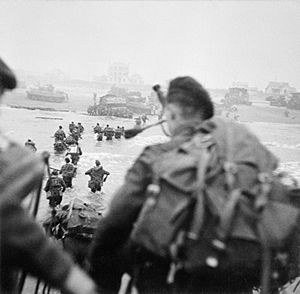
At first, Commandos looked like any other British soldier. They kept their old regimental hats and badges. But in 1942, the green Commando beret and the Combined Operations tactical recognition flash were adopted as their official uniform.
Because they were a light raiding force, Commandos didn't carry heavy anti-gas gear or large backpacks. They wore a woollen cap comforter instead of the heavy steel helmet. They also wore lightweight rubber-soled gym shoes to move silently. All Commandos carried a toggle rope. Several ropes could be linked to climb cliffs or other obstacles. For boat operations, they wore inflatable lifebelts. Commandos were the first unit to use the Bergen rucksack. This helped them carry heavy loads of ammunition and explosives. A special battle jerkin was made to wear over their uniforms. Later in the war, the camouflaged Denison smock became standard for Commandos.
Commando Missions
The very first Commando raid, Operation Collar on June 23, 1940, was done by a unit that came before the Commandos. This mission, led by Major Ronnie Tod, was a scouting attack on the French coast. It was a small success, with at least two German soldiers killed.
The size of a raiding force depended on the mission. The smallest raid involved just two men. The largest, Operation Jubilee, had 10,500 men. Most raids lasted only overnight, but some, like Operation Gauntlet, took several days. In northwest Europe, there were 57 raids between 1940 and 1944. Many were in France, Norway, and the Channel Islands.
Some raids were very successful, like Operation Chariot against the docks at St Nazaire. Others, like Operation Aquatint, resulted in all the Commandos being captured or killed. Smaller raids stopped in mid-1944. Major-General Robert Laycock believed they were no longer effective. He thought they only made the Germans strengthen their defenses, which could hurt future Allied plans.
Norway Missions
The first Commando raid in Norway, Operation Claymore, happened in March 1941. Men from Nos. 3 and 4 Commandos attacked the undefended Lofoten Islands. They successfully destroyed fish-oil factories, fuel dumps, and 11 ships. They also captured 216 Germans and important code equipment.
In December 1941, there were two raids. Operation Anklet was a raid on the Lofoten Islands by No. 12 Commando. The German soldiers were celebrating Christmas and were easily defeated. Operation Archery was a bigger raid on Vågsøy Island. This raid involved men from Nos. 2, 3, 4, and 6 Commandos, along with the Royal Navy and air support. They caused major damage to factories and warehouses. They also sank eight ships. After these raids, Germany sent 30,000 more troops to Norway. They also improved coastal defenses and sent more warships to the area.
In September 1942, men from No. 2 Commando took part in Operation Musketoon. This was a raid against the Glomfjord hydroelectric power plant. The Commandos landed by submarine and blew up pipelines, turbines, and tunnels. This destroyed the power station and shut down the aluminum plant. One Commando was killed, and seven were captured. They were later executed, becoming victims of the secret Commando Order. This order meant all captured Commandos were to be executed. The remaining three Commandos escaped to Sweden and returned to their unit.
In 1943, Norwegian Commandos helped the Royal Navy attack German shipping. In April 1943, seven men of No. 14 (Arctic) Commando attacked German ships near Haugesund. They sank several ships using limpet mines. However, they were captured and later executed in concentration camps.
Germany reacted to these raids by sending more troops to Norway. By 1944, there were 370,000 German soldiers there.
Channel Islands Missions
There were seven Commando missions on the Channel Islands. Operation Ambassador on Guernsey was the first and largest, with 140 men. Later raids were much smaller. For example, only 12 men took part in Operation Dryad in September 1942. They captured seven prisoners and found German codebooks.
Operation Basalt in October 1942 was a raid on Sark. Four Germans were killed, and one was captured. Other Channel Islands raids were less successful. In January 1943, Operation Huckabuck on Herm failed. The Commandos couldn't find any German troops. In December 1943, Operations Hardtack 28 and Hardtack 7 also failed. In Hardtack 28, two men were killed in a minefield, alerting the Germans. In Hardtack 7, Commandos couldn't climb the cliffs on Sark.
Mediterranean Missions
In 1941, the Middle East Commandos and Layforce were meant to harass enemy forces in the Mediterranean. They hoped to capture the island of Rhodes. However, the arrival of German forces in North Africa and the invasions of Yugoslavia and Greece changed the war. By the time Layforce arrived in Egypt, the situation was bad. Commandos became the only reserve troops.
In May 1941, most of Layforce was sent to help in the Battle of Crete. They were used to cover the retreat of other troops. They were not well-equipped for this, lacking heavy weapons like mortars. By May 31, the evacuation was ending. Commandos ran low on ammunition and water. Most were left behind on the island and became prisoners of war. About 600 of the 800 Commandos sent to Crete were killed, missing, or wounded. Only 179 escaped. Layforce was later disbanded because of heavy losses and lack of support.
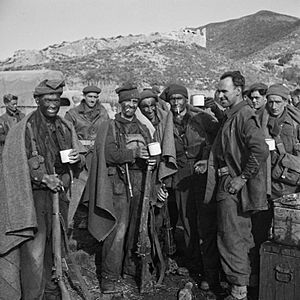
In November 1942, No. 1 and No. 6 Commandos helped lead Allied landings in Algeria as part of Operation Torch. To avoid conflict with French forces, Commandos used American weapons and uniforms. They were involved in the Tunisia Campaign and the first battle of Sedjenane in 1943. Both units were pulled out in April because they had suffered many losses and lacked support.
In May 1943, a Special Service Brigade with No. 2, No. 3, No. 40 (RM), and No. 41 (RM) Commandos went to the Mediterranean. They took part in the Allied invasion of Sicily. The Royal Marines Commandos were the first to land. The 2nd Special Service Brigade later fought in the Italian campaign. On April 2, 1945, the 2nd Commando Brigade fought in Operation Roast at Comacchio lagoon in Italy. After a fierce three-day battle, Commandos cleared the area. This helped the British 8th Army advance. Major Anders Lassen and Corporal Thomas Peck Hunter were awarded the Victoria Cross for their bravery during Operation Roast.
France Missions
Between 1940 and 1944, Commandos carried out 36 raids in France. Most were small, with 10 to 25 men. Some larger raids involved one or more Commando units. In March 1942, No. 2 Commando and demolition experts took part in Operation Chariot, the St. Nazaire Raid. The destroyer HMS Campbeltown rammed the dock gates. Commandos fought German forces and destroyed dock facilities. Hours later, explosives in the Campbeltown blew up, destroying the gates and killing many Germans and French. Of 611 soldiers and sailors, 169 were killed and 200 captured. Only 242 men returned. Lieutenant-Colonel Augustus Charles Newman and Sergeant Thomas Durrant of the Commandos were awarded the Victoria Cross.
On August 19, 1942, a major landing happened at Dieppe, France. The main force was Canadian, supported by No. 3 and No. 4 Commandos. No. 3 Commando's mission was to silence a German coastal battery. Their landing craft met a German convoy. Only a few Commandos landed and reached the battery. They couldn't destroy the guns, but they kept the Germans from firing effectively. No. 4 Commando landed with French and American Rangers. They successfully destroyed an artillery battery at Varengeville. Most of No. 4 Commando returned safely. Captain Patrick Porteous of No. 4 Commando received the Victoria Cross.
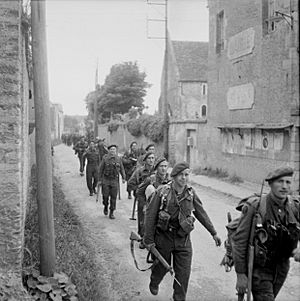
During the Normandy landings on June 6, 1944, two Special Service Brigades were used. The 1st Special Service Brigade landed behind the British 3rd Infantry Division on Sword Beach. Their goal was to reach the 6th Airborne Division and the bridges over the Orne River. Commandos cleared Ouistreham and headed for the bridges. They fought on the left side of the Orne bridgehead for ten weeks. The brigade suffered 1,000 casualties, including their commander, Brigadier Lord Lovat.
The Royal Marines 4th Special Service Brigade also took part in the Normandy landings. No. 48 Commando landed on the left of Juno Beach. No. 41 Commando landed on the right of Sword Beach and attacked Lion-sur-Mer. No. 48 Commando landed in front of a strong German position and lost 40% of its men. No. 47 Commando landed on Gold Beach. Five of their landing craft were sunk by mines, causing 76 deaths. This delayed their advance to Port-en-Bessin, which they captured the next day.
Netherlands Missions
The Battle of the Scheldt began on November 1, 1944. The 4th Special Service Brigade was to attack the island of Walcheren from the sea. The plan was to attack the island from two directions. Commandos would come by sea, and Canadian and Scottish divisions would attack across a causeway. No. 4 Commando landed at Flushing. Nos. 41 and 48 landed at Westkapelle. No. 47 Commando was in reserve.
On the first day, No. 41 captured an artillery tower and cleared Westkapelle. They then moved along the coast, dealing with defenses. No. 48 Commando quickly captured a radar station and a gun battery.
On November 2, No. 47 Commando attacked a gun battery at Zoutelande. The attack failed, and the unit suffered heavy losses. The next day, No. 47, supported by No. 48, attacked the Zoutelande battery again. This time, they advanced and linked up with No. 4 Commando. Capturing these batteries allowed the navy to clear mines into Antwerp. On November 5, No. 41 Commando captured another gun battery. This left only one battery under German control. The brigade regrouped and attacked the last position. Just before the attack on November 9, the 4,000 men in the battery surrendered. The rest of the island's German forces surrendered soon after.
Germany Missions
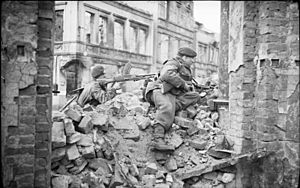
In January 1945, the 1st Commando Brigade was involved in Operation Blackcock. During this operation, Lance Corporal Henry Harden of the Royal Army Medical Corps, attached to No. 45 (Royal Marine) Commando, was awarded the Victoria Cross.
The 1st Commando Brigade then took part in Operation Plunder. This was the crossing of the Rhine River in March 1945. After a heavy artillery attack on March 23, the brigade made the first assault under cover of darkness. The Commandos crossed the Rhine near Wesel without opposition. They headed to the outskirts of Wesel. They waited for a Royal Air Force bombing raid to finish. After the raid, they moved into the city after midnight. Commandos met resistance from German defenders. It wasn't until March 25 that all resistance ended, and the brigade declared the city captured.
Burma Missions

During the Burma Campaign in 1944–1945, the 3rd Commando Brigade took part in several coastal landings. These landings led to the battle of Hill 170 at Kangaw. Here, Lieutenant George Knowland of No. 1 Commando was awarded a posthumous Victoria Cross. The Commandos' victory in the 36-hour battle for Hill 170 cut off the escape of the 54th Japanese Division. Other Allied landings and advances made the Japanese position difficult. The Japanese Army was ordered to withdraw to avoid being completely destroyed. The Commando brigade was then sent to India to prepare for Operation Zipper, an invasion of Malaya. However, Japan surrendered, so the invasion wasn't needed. The brigade was sent to Hong Kong for policing duties instead.
Legacy of the Commandos
At the end of World War II, most British Army, Royal Navy, Royal Air Force, and some Royal Marines Commandos were disbanded. Only three Royal Marines Commando units and one brigade remained. As of 2010, the main British Commando force is 3 Commando Brigade. It includes Royal Marines and British Army soldiers, plus commando-trained personnel from the Royal Navy and Royal Air Force. Other British special forces, like the Parachute Regiment, the Special Air Service, and the Special Boat Service, can trace their history back to the World War II Commandos.
Of the countries that had troops in No. 10 (Inter-Allied) Commando, only Norway did not create a similar force after the war. The French troops became the Commandos Marine. The Dutch troops became the Korps Commandotroepen. The Belgian troops became the Immediate Reaction Cell. The 1st Battalion of the United States Army Rangers was also influenced by the British Commandos. Their first volunteers trained at the Commando depot at Achnacarry.
Commandos received 479 decorations during the war. This included eight Victoria Crosses, the highest award for bravery. Officers received 37 Distinguished Service Orders and 162 Military Crosses. Other ranks received 32 Distinguished Conduct Medals and 218 Military Medals. In 1952, the Commando Memorial was unveiled by the Queen Mother. It is a special monument in Scotland, dedicated to the original British Commando Forces of World War II. It overlooks the training areas of the Commando Training Depot at Achnacarry Castle.
Battle Honours
In the British Army, battle honours are given to regiments that fought in important battles or campaigns, usually with a victory. The British Commandos received the following battle honours during World War II:
- Adriatic
- Alethangyaw
- Aller
- Anzio
- Argenta Gap
- Burma 1943–1945
- Crete
- Dieppe
- Dives Crossing
- Djebel Choucha
- Flushing
- Greece 1944–1945
- Italy 1943–1945
- Kangow
- Landing at Porto San Venere
- Landing in Sicily
- Leese
- Litani
- Madagascar
- Middle East 1941, 1942, 1944
- Monte Ornito
- Myebon
- Normandy Landings
- North Africa 1941–1943
- North-West Europe 1942, 1944, 1945
- Norway 1941
- Pursuit to Messina
- Rhine
- St. Nazaire
- Salerno
- Sedjenane 1
- Sicily 1943
- Steamroller Farm
- Syria 1941
- Termoli
- Vaagso
- Valli di Comacchio
- Westkapelle



